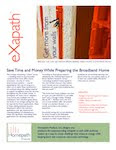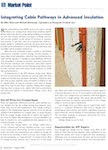History confirms that Mr. Ford was not ignoring his customers, simply listening better than most with vision firmly fixed on the horizon. A paradigm shift in the making.
Differentiate Begins with Different
The accomplishment of Ford and his enterprise is remarkable on many fronts. Revolutionizing production, vertical integration, value-based design, commonality of components and guerrilla marketing for its day.
Ford successfully shifted the expectations of his prospects to understand the value he proposed. From this grew many opportunities for others along with entirely new markets and industries to support them. No easy feat:
- Roads were primarily cobblestone or rutted cart paths
- Street cars, railroads and ferries were the de facto modes of mass transit
- Horses, carriages and wagons were the norm in personal transport
- Interstate highways did not exist
- Fueling stations were rare
- Repair shops scarce
It’s interesting to review advertisements from the early days. In 1908 Ford marketed the Model T. Print advertisements in black and white, likely all that was available, mainly textual with very limited graphics. A simple message - function, durability, and business sense “Eleven to seven. A merchant who knows says that it cost him eleven cents per delivery by horses and seven by Ford cars.”, obliquely targeting the newfound limitations of his prospects faithful steeds.
By the 1920s Ford had shifted mainstream customers toward the automobile and learned that growth and survival depended on addressing needs rather than simply providing a good product. This is reflected in the advertising of the twenties where graphics are emphasized, color introduced, and the message moving from durability and reliability toward lifestyle and choice...freedom and flexibility for Ford customers. A notion that rings true to this day.
(More Ford Motor Company advertisements can be found at www.thehenryford.org museum)
Life-Cycle Mismatch
A life-cycle mismatch exists between home building conventions and the changing needs of contemporary homeowners.
Today’s home construction paradigm is to overbuild with lots of permanently installed low voltage wiring. This includes in-wall cables for computers, television, home theater, whole-house audio, security and automation. On its face the habit makes sense. Many cables and outlets with all sorts of connectivity throughout the home for immediate and future needs. Structured wiring ready for TV, data, telephone, automation and security. What more could a homeowner want?
Less obvious when designing and building is that low voltage wires permanently embedded in your walls have real limitations in form factor and performance. This is not to say they’re poorly designed, rather that they sustain known performance requirements but fail to recognize how quickly the technology behind consumer electronics change.
Compare the life expectancy of any consumer electronic gadget to the lifespan of the home and a major mismatch becomes clear.
Disruption
In today’s residential design and construction community a welcomed shift toward sustainability is taking hold. As emphasized by the USGBC and NAHB, a key element in “green” construction is to minimize home energy consumption and conserve from there.
Using an integrative approach with collaboration between homeowners, architects, and builders, new homes are being right-sized with efficient climate control systems and building shell improvements including advanced insulation. Energy requirements reduced, conservation increased...a net gain in comfort with reduced carbon footprint.
So why be concerned with low voltage wiring?
It’s not the cables so much as the changes to those cables throughout the life of the home. We often rewire when new consumer electronics come to market. The process involves “snaking” behind sheetrock and within the stud cavity of the wall. While not obvious from the undisturbed surface, the process is destructive to properly installed insulation. Snaking wires through walls disrupts the insulation envelope creating voids, or thermal bridges, and opportunity for permanent heat energy escape. This works against modern principles of energy conservation in home design.
We Want Faster Wires
Like better transportation in the early twentieth century, faster wires will be necessary in the twenty-first, with continual upgrades throughout the life of the home.
To effectively answer this challenge, the home structure needs a way to rewire without disrupting its energy conserving nature. This is precisely what the eXapath™ in-wall cable pathways system from Homepath Products achieves. An idea that goes far beyond adding a cable chase from the attic to the basement or a few conduits in the walls.
- eXapath is about homeowners and their needs.
- It’s about adding the flexibility to rewire every wall.
- It’s about the ability to adapt to the latest technology.
- It’s about the flexibility to introduce technology from floor to ceiling.
- It’s about adding outlets before or after drywall without disruption to the insulation envelope.
- It’s about flexibility and choice.
Building Freedom and Flexibility for Modern Homeowners
We know the need to conserve energy is here to stay, and rightly so. Likewise, consumer electronics evolve and demand grows unabated.
Don’t just give homeowners what they want, give them what they need. Freedom and flexibility for a modern lifestyle. Choice.
Couple the integrative design/build approach emphasized by the USGBC and NAHB with eXapath. Play a role in shifting the latest paradigm.
Energy savings and replaceable cabling.











.jpg)


I can't believe I am the first commenting on this article. . . so I guess Ford is the perfect example of being ahead of the curve. thanks for the thoughtful article. stay the course my friend. jb @BMoxieBMore
ReplyDeleteThanks jb...
ReplyDeleteTook me a few weeks to get to this one Mike. What a great post. You know I love the product and your post sells it great. Its the business concepts and tie in to Ford that really blew me away. I have followed you for some time but failed to realize what a tremendous writer you are!
ReplyDeleteThanks Marc,
ReplyDeleteI really enjoyed writing this piece as it gave me an opportunity to add perspective to the changes we're hoping to bring to the residential, MDU, and light commercial construction arena.
Technology changes so quickly that it's difficult for structures to keep up. With a simple change like eXapath as an adaptive element during design and construction, home and building owners benefit for generations to come.
Thanks for commenting.
Mike